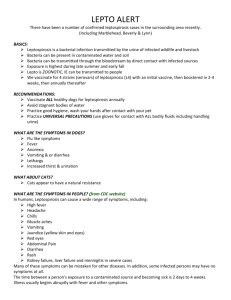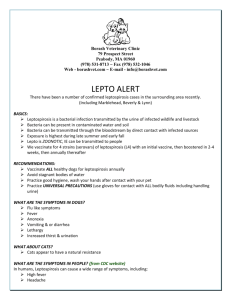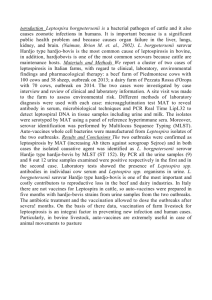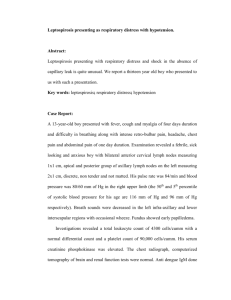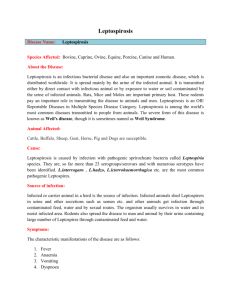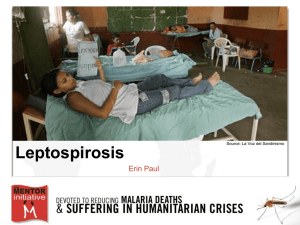Leptospirosis Importance
advertisement
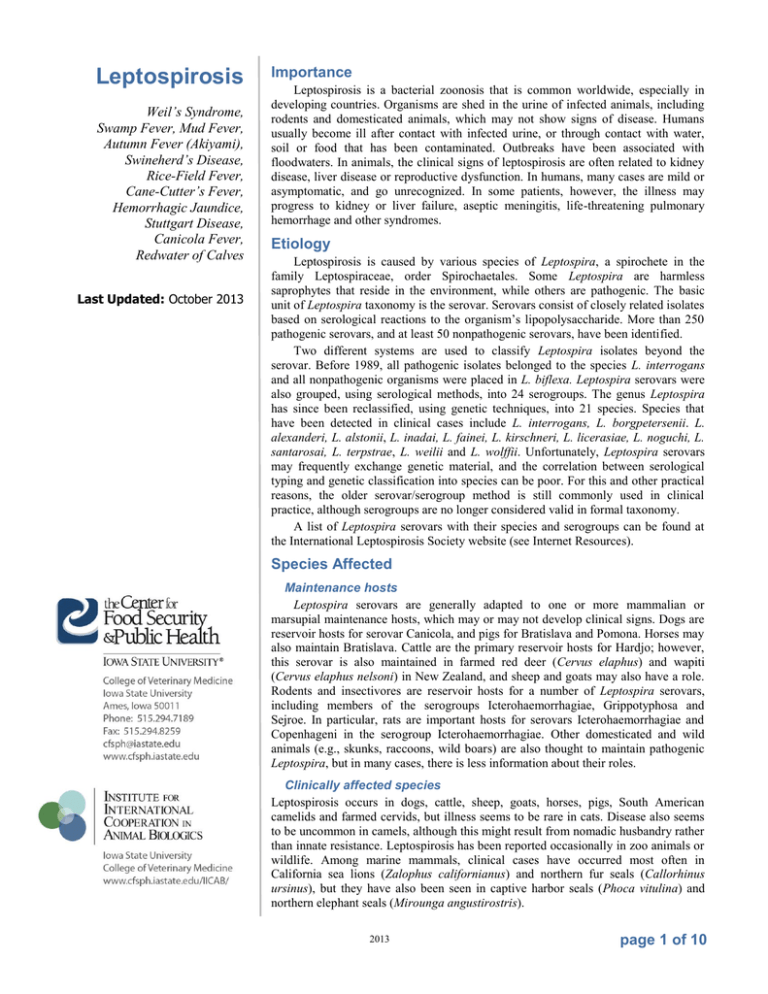
Leptospirosis Weil’s Syndrome, Swamp Fever, Mud Fever, Autumn Fever (Akiyami), Swineherd’s Disease, Rice-Field Fever, Cane-Cutter’s Fever, Hemorrhagic Jaundice, Stuttgart Disease, Canicola Fever, Redwater of Calves Last Updated: October 2013 Importance Leptospirosis is a bacterial zoonosis that is common worldwide, especially in developing countries. Organisms are shed in the urine of infected animals, including rodents and domesticated animals, which may not show signs of disease. Humans usually become ill after contact with infected urine, or through contact with water, soil or food that has been contaminated. Outbreaks have been associated with floodwaters. In animals, the clinical signs of leptospirosis are often related to kidney disease, liver disease or reproductive dysfunction. In humans, many cases are mild or asymptomatic, and go unrecognized. In some patients, however, the illness may progress to kidney or liver failure, aseptic meningitis, life-threatening pulmonary hemorrhage and other syndromes. Etiology Leptospirosis is caused by various species of Leptospira, a spirochete in the family Leptospiraceae, order Spirochaetales. Some Leptospira are harmless saprophytes that reside in the environment, while others are pathogenic. The basic unit of Leptospira taxonomy is the serovar. Serovars consist of closely related isolates based on serological reactions to the organism’s lipopolysaccharide. More than 250 pathogenic serovars, and at least 50 nonpathogenic serovars, have been identified. Two different systems are used to classify Leptospira isolates beyond the serovar. Before 1989, all pathogenic isolates belonged to the species L. interrogans and all nonpathogenic organisms were placed in L. biflexa. Leptospira serovars were also grouped, using serological methods, into 24 serogroups. The genus Leptospira has since been reclassified, using genetic techniques, into 21 species. Species that have been detected in clinical cases include L. interrogans, L. borgpetersenii. L. alexanderi, L. alstonii, L. inadai, L. fainei, L. kirschneri, L. licerasiae, L. noguchi, L. santarosai, L. terpstrae, L. weilii and L. wolffii. Unfortunately, Leptospira serovars may frequently exchange genetic material, and the correlation between serological typing and genetic classification into species can be poor. For this and other practical reasons, the older serovar/serogroup method is still commonly used in clinical practice, although serogroups are no longer considered valid in formal taxonomy. A list of Leptospira serovars with their species and serogroups can be found at the International Leptospirosis Society website (see Internet Resources). Species Affected Maintenance hosts Leptospira serovars are generally adapted to one or more mammalian or marsupial maintenance hosts, which may or may not develop clinical signs. Dogs are reservoir hosts for serovar Canicola, and pigs for Bratislava and Pomona. Horses may also maintain Bratislava. Cattle are the primary reservoir hosts for Hardjo; however, this serovar is also maintained in farmed red deer (Cervus elaphus) and wapiti (Cervus elaphus nelsoni) in New Zealand, and sheep and goats may also have a role. Rodents and insectivores are reservoir hosts for a number of Leptospira serovars, including members of the serogroups Icterohaemorrhagiae, Grippotyphosa and Sejroe. In particular, rats are important hosts for serovars Icterohaemorrhagiae and Copenhageni in the serogroup Icterohaemorrhagiae. Other domesticated and wild animals (e.g., skunks, raccoons, wild boars) are also thought to maintain pathogenic Leptospira, but in many cases, there is less information about their roles. Clinically affected species Leptospirosis occurs in dogs, cattle, sheep, goats, horses, pigs, South American camelids and farmed cervids, but illness seems to be rare in cats. Disease also seems to be uncommon in camels, although this might result from nomadic husbandry rather than innate resistance. Leptospirosis has been reported occasionally in zoo animals or wildlife. Among marine mammals, clinical cases have occurred most often in California sea lions (Zalophus californianus) and northern fur seals (Callorhinus ursinus), but they have also been seen in captive harbor seals (Phoca vitulina) and northern elephant seals (Mirounga angustirostris). 2013 page 1 of 10 Leptospirosis The most common Leptospira serovars in clinical cases vary with the host species and geographic region, and sometimes with selection pressures from vaccination. Icterohaemorrhagiae and Canicola were once the most common serovars in symptomatic dogs, but the introduction of Icterohaemorrhagiae/ Canicola vaccines has resulted in the increasing prominence of other serovars. Pathogenic Leptospira spp. do not multiply outside the host. In the environment, they require high humidity for survival and are killed by dehydration or temperatures greater than 50°C (122°F). These organisms may remain viable in the environment for several months under optimal conditions, e.g., in water or contaminated soil. They survive best in bodies of water that are slow-moving or stagnant. Zoonotic potential A variety of Leptospira species and serovars can cause disease in humans; however, members of L. interrogans and L. borgpetersenii are found most often. People are usually considered to be incidental hosts, which do not act as reservoirs for these organisms. One recent study suggested that people might maintain Leptospira in certain environments such as the Peruvian Amazon. Disinfection Geographic Distribution Pathogenic Leptospira species have been found worldwide, on all continents except Antarctica. Leptospirosis is most common in warm, humid environments. Areas with a high disease incidence in humans include the Caribbean and Latin America, Oceania and parts of Asia. Leptospirosis also appears to be common in Africa, although surveillance is limited. Some Leptospira serovars are widely distributed, while others occur in limited areas. The predominant serovars in a host species can vary with the region. Transmission Leptospirosis can be transmitted either directly between hosts or indirectly through the environment. Leptospira spp. can be ingested in contaminated food or water, spread in aerosolized urine or water, or transmitted by direct contact with the skin. The organisms usually enter the body through mucous membranes or abraded skin. They might also be able to penetrate intact skin that has been immersed for a long time in water, although this is controversial. Leptospira spp. are excreted in the urine of both acutely and chronically infected animals. Chronic carriers may shed these organisms for months or years. Although humans can also shed Leptospira in the urine, prolonged shedding seems to be uncommon; most people excrete these bacteria for 60 days or less. In animals, Leptospira can be found in aborted or stillborn fetuses, as well as in normal fetuses or vaginal discharges after giving birth. They can be isolated from the male and female reproductive organs in some species, and these infections may persist for long periods. For example, serovar Hardjo may be found in the reproductive tract of both cows and bulls for more than a year. In rare instances, human cases have also been transmitted during sexual intercourse, or by breast feeding. Other uncommon routes of exposure in people include rodent bites and laboratory accidents. Last Updated: October 2013 © 2013 Leptospira can be inactivated by 1% sodium hypochlorite, 70% ethanol, iodine-based disinfectants, quaternary ammonium disinfectants, accelerated hydrogen peroxide, glutaraldehyde, formaldehyde, detergents and acid. This organism is sensitive to moist heat (121°C [249.8°F] for a minimum of 15 min). It is also killed by pasteurization. Infections in Animals Incubation Period The incubation period can be as short as a few days, with clinical signs appearing after 5 to 15 days in experimentally infected dogs. It may be longer when clinical signs are the result of chronic, low level damage to the kidneys or liver. Rare case reports in cats suggest the possibility of prolonged incubation periods in this species. Abortions usually occur 2 to 12 weeks after infection in cattle, and 1 to 4 weeks after infection in pigs. Clinical Signs Leptospira infections may be asymptomatic, mild or severe, and acute or chronic. The illness tends to be milder in the reservoir host, and more severe when the serovar is not adapted to the host species. The clinical signs are often related to kidney disease, liver disease or reproductive dysfunction, but other organs can be affected. Cattle Acute leptospirosis occurs mainly in calves. The clinical signs may include fever, anorexia, conjunctivitis and diarrhea, and in more severe cases, jaundice, hemoglobinuria, hemolytic anemia, pneumonia or signs of meningitis (e.g., incoordination, salivation, muscle rigidity). Some infections can be fatal, and the survivors may be unthrifty after recovery. In adult cattle, early signs such as fever and depression are often absent, or transient and mild, and may not be observed. The first signs of illness, in many cases, are abortions, stillbirths, and occasionally, weak calves with increased neonatal mortality. Because only cows infected for the first time during pregnancy are usually affected, reproductive losses may occur sporadically or as an outbreak. Some aborting cows may retain the placenta, and infertility can be a sequela. Some Leptospira serovars can cause sudden agalactia or decreased milk production. The milk may be thick, yellow and blood-tinged but there is page 2 of 10 Leptospirosis typically little evidence of mammary inflammation. The appearance of the milk usually improves after a few days, and milk production returns to normal within a few weeks. Jaundice may be seen in some severely affected cows. Sheep and goats Leptospirosis in sheep and goats is similar to the disease in cattle. Acute cases occur most often in lambs and goat kids, and are characterized by fever and anorexia, and sometimes jaundice, diarrhea, hemoglobinuria or anemia. Adults usually have reproductive losses (abortions, stillbirths, weak lambs or kids, infertility and decreased milk production), either with or without other clinical signs. Swine Leptospirosis is usually subclinical in swine herds, except when they are first infected. The most common signs are reproductive losses, with late term abortions, infertility, stillbirths, mummified or macerated fetuses, and increased neonatal mortality. Fever, decreased milk production and jaundice may also be seen. In some herds, a transient fever may be the only sign of infection. Acute leptospirosis has been described in piglets, with clinical signs that may include fever, anorexia, depression, diarrhea, jaundice, hemoglobinuria, gastrointestinal signs and signs of meningitis. Affected piglets may grow more slowly than normal, and mortality may be high in young or weak piglets. South American camelids Leptospirosis has been associated with reproductive losses in South American camelids. Deer Leptospirosis is a significant problem among farmed deer in New Zealand, particularly animals less than a year of age. Lethargy and hematuria were the principal clinical signs in some outbreaks. Other signs included jaundice, photosensitization, corneal opacity, anemia and poor weight gain. Sudden death was reported in some cases. Poor reproductive performance and abortions were thought to be linked to leptospirosis in some herds, but confirmation is currently unavailable. Horses As in other species, leptospirosis can cause reproductive losses in mares. Abortions tend to occur late in gestation, sometimes after a mild, nonspecific illness, but often without previous systemic signs. In a few cases, foals have been born emaciated and icteric, either prematurely or at full term. The icteric form of leptospirosis occurs primarily in foals. The clinical signs can range from low fever, anorexia and listlessness in mild cases, to depression, conjunctival suffusion, jaundice, anemia and petechiae. Kidney failure is possible. A recent case series suggests that Leptospira may also cause pulmonary hemorrhage and severe respiratory Last Updated: October 2013 © 2013 distress, with a high mortality rate, in some foals. Some authors suggest that infections might be correlated with an increased risk of pulmonary hemorrhage in adult racehorses, but this remains to be confirmed. Leptospirosis is also an important cause of equine recurrent uveitis. This condition occurs weeks to months or years after the horse was infected, usually subclinically. It is characterized by periods of severe inflammation, interspersed with more quiescent periods. During the acute phase, there may be fever, conjunctivitis, corneal edema, miosis and iritis, with photophobia, blepharospasm, lacrimation and other signs of ocular pain. Corneal opacity and periodic ophthalmia can be sequelae of acute infections. In the chronic phase, there may be anterior and posterior adhesions of the eye, vitreous exudates, cataracts, lens luxation, uveitis and other abnormalities. Dogs The syndromes and disease severity are highly variable in dogs. The initial clinical signs are usually nonspecific, and may include fever, depression, anorexia, stiffness, myalgia, shivering and weakness. The mucus membranes are often injected. Later, there may be signs of kidney involvement, with polydipsia, polyuria, oliguria, or anuria, and hematuria or dehydration in some cases. Fever may or may not be apparent in dogs that present with kidney signs. Vomiting, diarrhea, abdominal pain, gray stools, weight loss, jaundice, conjunctivitis and abortions can also be seen. Hemorrhagic syndromes occur in some dogs: the mucus membranes may have petechial and ecchymotic hemorrhages, and in later stages of the disease, there may be other signs such as hemorrhagic gastroenteritis and epistaxis. Leptospiral pulmonary hemorrhage syndrome has been seen in dogs, and can cause coughing, tachypnea or dyspnea. Vasculitis may result in peripheral edema and mild pleural or peritoneal effusion. Evidence of pancreatitis or myocardial involvement (ECG alterations) has also been reported. Deaths can occur at any time, including the acute stage. Chronic kidney disease can be a sequela. Chronic infections may be asymptomatic, or associated with fever of unknown origin. There may also be a link between leptospirosis and some cases of chronic hepatitis. Cats Clinical leptospirosis appears to be uncommon in cats, but rare cases with kidney signs, icterus, uveitis and/or lameness have been reported. Experimentally infected cats had only mild clinical signs (mild temperature elevation, polyuria/ polydipsia), although some animals had histopathological evidence of inflammation in the kidneys and liver. Free-living and captive wildlife There are relatively few reports of clinical leptospirosis among wildlife, with the exception of pinnipeds. Although seals and sea lions can be infected asymptomatically, clinical cases and outbreaks have been seen both in page 3 of 10 Leptospirosis captivity and in the wild. The clinical signs included depression, dehydration, vomiting, polydipsia and fever, as well as abortions and neonatal deaths. Affected sea lions are typically reluctant to use their hind flippers, and assume a hunched position with the flippers held over the abdomen. A few case reports have documented leptospirosis in other species. The clinical signs in two black rhinoceroses (Diceros bicornis michaeli) included acute depression, anorexia, gastrointestinal discomfort with reduced fecal output, rear leg trembling, dysuria and glucosuria. One animal died rapidly, but the other survived with treatment. Illnesses that might have been caused by Leptospira were reported in a captive cougar (Puma concolor) with fatal interstitial nephritis, and a wild cougar that was concurrently infected with FeLV. Clinical cases, some severe, have also been reported uncommonly in nonhuman primates. Many infections in wildlife, particularly rodents, are thought to be asymptomatic. Post Mortem Lesions Click to view images The kidneys are often swollen in animals with systemic signs. They may be pale or contain red or white/gray spots, mottling, bands of tissue or fibrotic scarring. The liver may also be enlarged, and can sometimes have necrotic foci. In dogs, it is often friable, with a prominent lobular pattern. Hemorrhages, particularly petechiae or ecchymoses, may be present in various organs. Hematuria may also be found. There may also be icterus, abnormalities associated with acute uremia, pulmonary lesions or other lesions. Diagnostic Tests Leptospirosis can sometimes be diagnosed by detecting the organism, its antigens or nucleic acids in clinical samples such as blood (acute infections), urine and milk, or liver, kidney and other tissue samples collected at necropsy. Shedding of organisms in the urine may be either continuous or intermittent. Leptospira is usually identified in clinical samples by immunofluorescence or immunohistochemical staining, or polymerase chain reaction (PCR) techniques. These organisms stain poorly with the Gram stain, and are not observed by microscopy unless special stains or methods are employed. Silver staining or immunogold-silver staining is sometimes useful as an adjunct technique. Darkfield microscopy can also be used to detect Leptospira; however, this technique is nonspecific and not very sensitive. Culture is definitive, but the availability of this test is limited. Leptospira spp. can be isolated on a variety of media, but they are fastidious and grow slowly on primary isolation. Special transport media may be required for shipment to the laboratory. Depending on the serovar, culture can take up to 13 to 26 weeks. Identification to the species, serogroup and/or serovar level is done by reference laboratories, using genetic and immunological techniques. Serology is often used to diagnose leptospirosis. Caution must be used in interpreting serological test results, Last Updated: October 2013 © 2013 as subclinical infections are common; the vaccination status of the animal must be considered; antibodies may not be present early in the illness; and antibody titers can become low or undetectable in some chronically infected animals. Paired acute and convalescent samples are preferred from most animals, and rising antibody titers are usually seen in acute cases. Single samples with high titers increase the suspicion of leptospirosis, although they are not definitive. However, a single positive sample from an aborted fetus is diagnostic. Herd tests are often used in ruminants. The most commonly used serological tests in animals are the microscopic agglutination test (MAT) and enzyme-linked immunosorbent assays (ELISAs). The MAT evaluates antibody responses to a selection of Leptospira serovars (often 5-7 in veterinary assays). This test is serogroup but not serovar specific, although it may suggest a likely serovar. False negatives are possible if the infecting serogroup was not included in the MAT panel. ELISAs, including a bovine milk ELISA, are available for some species of animals. Treatment Various antibiotics including tetracyclines (e.g., doxycycline), penicillins, dihydrostreptomycin and streptomycin may be used to treat leptospirosis. Fluid therapy, blood transfusions, respiratory support, and other supportive care may also be necessary. The primary treatment for equine recurrent uveitis in horses is anti-inflammatory drugs and medications to decrease discomfort (e.g., mydriatic cyclopegics such as topical atropine). Surgery (pars plana vitrectomy) and other therapies may also be used. Prevention Leptospirosis vaccines are widely available for pigs, cattle, and dogs. In some countries, vaccines may also be licensed or used in other species such as sheep, goats or farmed deer. Vaccines are usually protective only against the included or closely related serovars, and their content may need to be changed periodically. Most bovine vaccines contain serovar Hardjo, and most porcine vaccines contain Pomona, although other serovars may be included depending on the region. Vaccines for dogs have traditionally contained Icterohaemorrhagiae and Canicola, but additional serovars are now included in some vaccines, particularly in North America. In addition to routine use, vaccines are sometimes used to help prevent further abortions in livestock herds in the face of an outbreak. Isolation and treatment of infected animals reduces the risk that they may spread the infection to contacts. Prophylactic treatment with antibiotics can be used to prevent disease in exposed animals. Environmental control measures and sanitation may also reduce the risk of infection, although their practicality varies with the host species and situation. Such measures include providing safe drinking water, and preventing contact with contaminated environments (e.g., lakes) or page 4 of 10 Leptospirosis infected domesticated animals and wildlife, particularly rodents. Good sanitation can reduce the risk of infection in kennels, and in areas where livestock are bred or give birth. Quarantine and testing of newly acquired livestock, or new equine studs on a farm, can also help prevent the introduction of Leptospira. Large-scale eradication programs have not been widely used for leptospirosis; however, a control program has virtually eliminated serovar Hardjo from cattle herds in the Netherlands. This program includes regular testing of bulk tank milk with a Hardjo-specific ELISA, antibiotic treatment of infected cattle, and certification of Hardjo-free farms. Its success depends, in part, on the absence of serovar Hardjo in wildlife hosts. Morbidity and Mortality Leptospirosis is particularly prevalent in warm and humid climates, and marshy or wet areas. This disease is often seasonal: it is most common during the rainy season in the tropics, and in the summer and fall in temperate regions. Morbidity and mortality vary with the species and age of the animal, the host specificity of the serovar, and other factors. Leptospirosis is often asymptomatic or mild in adult pigs and cattle, and reproductive signs are the main evidence of infection. In newly infected cattle herds, up to 40% or more of the cows may abort. In endemically infected herds, abortions are usually sporadic and occur mainly in younger animals. Young livestock may be more severely affected, and can develop acute disease. In dogs, the risk of infection can vary with lifestyle factors, such as exposure to lakes and ponds. With treatment, 80% of dogs are expected to survive even when the kidneys are involved. However, the prognosis is poorer in cases with severe pulmonary complications. Domesticated cats rarely seem to be affected, although serological surveys report that up to 35% of cats may be exposed in some populations. There is little information about the impact of leptospirosis, if any, on most wildlife species. In some areas, major outbreaks occur periodically among wild California sea lions. Infections in Humans Incubation Period The incubation period in humans is usually 7 to 12 days, with a range of 2 to 29 days. Clinical Signs Human infections vary from asymptomatic to severe. While the classic presentation is a biphasic illness, leptospirosis can occur in many forms, which include mild, flu-like cases that may not be recognized as leptospirosis, as well as unusual syndrome or progressive fulminant illness without two distinct phases. Last Updated: October 2013 © 2013 The first stage of the classical biphasic illness is called the acute or septicemic phase. It usually begins abruptly, and is characterized by nonspecific signs such as fever, chills, headache and conjunctival suffusion. Myalgia, which typically affects the back, thighs or calves, is often severe. Some patients also have other signs, such as weakness, photophobia, lymphadenopathy, abdominal pain, nausea, vomiting, a transient rash, sore throat, coughing or chest pain. Occasionally, there may be aseptic meningitis, jaundice or other syndromes typically seen in the second stage of leptospirosis. The first stage usually lasts several days to approximately a week, and is followed by a brief remission, during which the temperature drops and the symptoms abate or disappear. Many patients recover completely at this point. Others enter the second stage, which is called the “immune phase” because antiLeptospira antibodies develop at this time. Patients in the second stage of leptospirosis develop either anicteric or icteric disease. The anicteric form is more common. Although serious illness is usually uncommon in this form, and deaths are rare, a number of patients develop aseptic meningitis. This syndrome is characterized by a severe headache, stiff neck and other meningeal symptoms, and typically lasts a few days. Icteric leptospirosis is more severe. It occurs in 5–10% of all patients, is often rapidly progressive, and may be associated with multiorgan failure. In this form, there may be no period of improvement between the septicemic and immune phases. The most commonly involved organ systems are the liver, kidneys and central nervous system. Jaundice can be severe and may give the skin an orange tone, and acute renal failure occurs in a significant number of cases. Some patients also have hemorrhages of varying severity, from petechiae and epistaxis to severe bleeding in the gastrointestinal tract and other organs. Some cases of icteric leptospirosis are fatal, and convalescence may be prolonged. A severe pulmonary form of leptospirosis occurs in less than 5% of symptomatic patients, but has been an important cause of death in some recent outbreaks. It can be seen in both the anicteric and icteric forms, and usually appears on the 4th to 6th day of illness. It is characterized by pulmonary hemorrhage and edema, with dyspnea and hemoptysis, and can be rapidly fatal. Uncommonly or rarely reported syndromes in leptospirosis include pancreatitis, acute cholecystitis, neurological syndromes other than aseptic meningitis, immune-mediated signs such as reactive arthritis, and muscle abnormalities such as rhabdomyolysis. Abortions, fetal death, and rare congenital infections have been seen in a few cases Up to 10% of leptospirosis patients develop anterior or diffuse uveitis, a few weeks to a year after recovery. The severity of this condition varies, and the inflammation may be acute or recurrent. It usually has a good prognosis, when treated, and some cases may be self-limiting. page 5 of 10 Leptospirosis Diagnostic Tests In humans, the first stage of the biphasic illness occurs before antibodies develop, and early cases must be diagnosed with assays that detect the organism, its antigens or nucleic acids. In humans, Leptospira may be found in the blood, cerebrospinal fluid, urine or tissue samples. The tests used are similar to those employed in animals, and include immunofluorescence and immunohistochemical staining, PCR, culture and microscopy. While the serovar is often not determined, it can be helpful in the epidemiology of cases and outbreaks, and in targeting prevention methods to the most likely source of the infection. In many cases, leptospirosis is diagnosed by serology, especially the MAT or ELISAs. A high titer with consistent symptoms is suggestive of an acute case, but a rising titer is necessary for a definitive diagnosis. The MAT may be positive 10-12 days after the initial signs. Human clinical laboratories often include more than 20 serovars in this test; however, false negatives are still possible if the infecting serogroup is absent, especially in travelers. Less commonly used serological tests include various agglutination assays, rapid screening tests (e.g., dipstick tests or lateral flow immunochromatography), and immunofluorescence or indirect immunoperoxidase staining. Rapid screening tests should be confirmed with other assays. Treatment The benefits of antibiotic treatment for leptospirosis have not been clearly demonstrated in rigorously controlled scientific studies However, most authors, as well as the World Health Organization, recommend their use, particularly in severe disease. The Jarisch-Herxheimer reaction, a febrile acute inflammatory reaction seen after antibiotic treatment of spirochete infections, is a possible complication. Supportive treatment and management of complications such as renal failure, liver disease, pulmonary dysfunction, hemorrhages and CNS signs may also be necessary. Mild cases are often self-limited. Treatment for leptospiral uveitis, which appears to be an immune-mediated condition, usually consists of corticosteroids and mydriatics. Prevention Controlling infections in livestock and pets can reduce the risk of human disease, but wildlife reservoirs and contaminated environments complicate prevention. Rodent control can be important, particularly in urban areas. Other protective measures include avoiding contact with potentially contaminated water (e.g., lakes), and protecting food from contamination. Improvements in sanitation reduce the risk of leptospirosis in urban slums. Environmental modifications such as draining wet areas may decrease the incidence of disease, but are not always feasible or desirable. Personal hygiene and protective clothing are important preventive measures in high risk occupations. Gloves and Last Updated: October 2013 © 2013 protective clothing should be used when working with infected animals or tissues, with the addition of face shields or protective eyewear and face masks when the organisms might be aerosolized. Rubber boots decrease the risk of leptospirosis when wading in urine-contaminated water. Doxycycline has been used for short term prophylaxis. Human vaccines are available in a limited number of countries. Immunization protects only against the serovar in the vaccine or closely related serovars, and regular boosting is required. The currently available vaccines generally consist of organisms killed by phenol or formaldehyde, and can have side effects including painful swelling. Morbidity and Mortality Leptospirosis is one of the most important zoonoses worldwide. The annual incidence of endemic human disease is thought to be 0.1-1 cases per 100,000 population in temperate areas, and 10-100 cases per 100,000 population in humid tropical regions. These are likely to be underestimates, as mild, self-limited cases are underdiagnosed and underreported. Leptospirosis tends to be a seasonal disease, with most cases occurring in the summer and fall in temperate regions. In tropical climates, the peak incidence is during the rainy season. Large outbreaks can be seen after floods. Additional risk factors include occupational exposure, recreational activities, and residence or travel in countries where the organisms are common in the environment. Occupations with an increased risk of infection include those that involve handling animals or animal products (e.g., farm workers, veterinarians, meat handlers), or frequent contact with contaminated environments (sewer workers, coal miners, plumbers, workers in the fishing industry, members of the military). Recreational activities such as gardening and water sports also increase the risk of leptospirosis. Several outbreaks have occurred in recent years among triathletes. In addition, this disease is common in some urban areas where sanitation is poor and residents are exposed via rat urine. Most cases of leptospirosis are asymptomatic or mild. The overall case fatality rate is estimated to be 1–5%, but varies with the form of the disease, the health and age of the study group, the availability of medical care and other factors. Children are generally thought to have milder cases than adults and perhaps adolescents. The anicteric form is rarely fatal, unless serious pulmonary complications develop. The icteric form has an overall case fatality rate of 5–15%, with higher rates reported in some studies. The case fatality rate in the severe pulmonary form of leptospirosis ranges from 30% to 60%, and the prognosis is grave even with intensive treatment. This syndrome was the major cause of death in some recent epidemics. page 6 of 10 Leptospirosis Internet Resources Centers for Disease Control and Prevention (CDC) http://www.cdc.gov/leptospirosis/index.html eMedicine.com. Leptospirosis http://emedicine.medscape.com/article/788751overview FAO Manual on Meat Inspection for Developing Countries http://www.fao.org/docrep/003/t0756e/t0756e00.htm International Leptospirosis Society http://www.med.monash.edu.au/microbiology/staff/adl er/ils.html International Veterinary Information Service (IVIS) http://www.ivis.org Public Health Agency of Canada. Pathogen Safety Data Sheets http://www.phac-aspc.gc.ca/lab-bio/res/psds-ftss/indexeng.php The Merck Manual http://www.merckmanuals.com/professional/index.html The Merck Veterinary Manual http://www.merckmanuals.com/vet/index.html World Health Organization (WHO). Leptospirosis http://www.who.int/topics/leptospirosis/en/ WHO Leptospirosis fact sheet http://www.searo.who.int/about/administration_structur e/cds/CDS_leptospirosis-Fact_Sheet.pdf World Organization for Animal Health (OIE) http://www.oie.int/ OIE Manual of Diagnostic Tests and Vaccines for Terrestrial Animals http://www.oie.int/en/international-standardsetting/terrestrial-manual/access-online/ OIE Terrestrial Animal Health Code http://www.oie.int/international-standardsetting/terrestrial-code/access-online/ References Acha PN, Szyfres B. (Pan American Health Organization [PAHO]). Zoonoses and communicable diseases common to man and animals. Volume 1. Bacterioses and mycoses. 3rd ed. Washington DC: PAHO; 2003. Scientific and Technical Publication No. 580. Leptospirosis; p. 157-68. Adesiyun AA, Baboolal S, Suepaul S, Dookeran S, StewartJohnson A. Human leptospirosis in the Caribbean, 1997-2005: characteristics and serotyping of clinical samples from 14 countries.Rev Panam Salud Publica. 2011;29(5):350-7. Last Updated: October 2013 © 2013 Adler B, Lo M, Seemann T, Murray GL. Pathogenesis of leptospirosis: The influence of genomics. Vet Microbiol. 2011;153(1-2):73-81. Animal Health Australia. National Animal Health Information System (NAHIS). Leptospirosis. NAHIS; 2004 July. Available at: http://www.aahc.com.au/nahis/disease/dislist.asp.* Accessed 6 Oct 2004. Arbour J, Blais MC, Carioto L, Sylvestre D. Clinical leptospirosis in three cats (2001-2009). J Am Anim Hosp Assoc. 2012;48(4):256-60. Ayanegui-Alcerreca MA, Wilson PR, Mackintosh CG, CollinsEmerson JM, Heuer C, Midwinter AC, Castillo-Alcala F. Leptospirosis in farmed deer in New Zealand : a review.N Z Vet J. 2007;55(3):102-8. Baitchman EJ, Calle PP, James SB, Linn MJ, Raphael BL. Leptospirosis in Wied's marmosets (Callithrix kuhlii). J Zoo Wildl Med. 2006;37(2):182-5. Bal AM. Unusual clinical manifestations of leptospirosis. J Postgrad Med. 2005;51(3):179-83. Berman SJ, Tsai CC, Holmes K. Sporadic anicteric leptospirosis in South Vietnam: a study in 150 patients. Ann Intern Med. 1973;79(2):167–173. Brett-Major DM, Coldren R. Antibiotics for leptospirosis. Cochrane Database Syst Rev. 2012;2:CD008264. Broux B, Torfs S, Wegge B, Deprez P, van Loon G. Acute respiratory failure caused by Leptospira spp. in 5 foals. Vet Intern Med. 2012;26(3):684-7. Canadian Laboratory Centre for Disease Control. Material Safety Data Sheet - Leptospira interrogans. Office of Laboratory Security; 2001 March. Available at: http://www.phacaspc.gc.ca/lab-bio/res/psds-ftss/msds95e-eng.php. Accessed Aug 2013. Chatfield J, Milleson M, Stoddard R, Bui DM, Galloway R. Serosurvey of leptospirosis in feral hogs (Sus scrofa) in Florida. J Zoo Wildl Med. 2013;44(2):404-7. Centers for Disease Control and Prevention [CDC]. Leptospirosis [online]. CDC; 2013 Jun. Available at: http://www.cdc.gov/leptospirosis/. Accessed 20 Aug 2013. Centers for Disease Control and Prevention [CDC]. Leptospirosis technical information [online]. CDC; 2003 Dec. Available at: http://www.cdc.gov/ncidod/dbmd/diseaseinfo/leptospirosis_t.h tm.* Accessed 4 Oct 2004. Cerqueira GM, Picardeau M. A century of Leptospira strain typing. Infect Genet Evol. 2009;9(5):760-8. Chow E, Deville J, Nally J, Lovett M, Nielsen-Saines K. Prolonged leptospira urinary shedding in a 10-year-old girl. Case Rep Pediatr. 2012;2012:169013. Colegrove KM, Lowenstine LJ, Gulland FM. Leptospirosis in northern elephant seals (Mirounga angustirostris) stranded along the California coast.J Wildl Dis. 2005;41(2):426-30. Corney B. Cattle diseases: Leptospirosis [online]. Department of Primary Industries and Fisheries, Animal and Plant Health Service Queensland, Australia; 2003 Aug. Available at: http://www.dpi.qld.gov.au/health/3573.html.* Accessed 6 Oct 2004. Costa F, Martinez-Silveira MS, Hagan JE, Hartskeerl RA, Dos Reis MG, Ko AI. Surveillance for leptospirosis in the Americas, 1996-2005: a review of data from ministries of health. Rev Panam Salud Publica. 2012;32(3):169-77. page 7 of 10 Leptospirosis Czopowicz M, Kaba J, Smith L, Szalus-Jordanow O, Nowicki M Witkowski L, Frymus Tl. Leptospiral antibodies in the breeding goat population of Poland. Vet Rec. 2011 27;169(9):230. Daher Ede F, Brunetta DM, de Silva Júnior GB, Puster RA, Patrocínio RM. Pancreatic involvement in fatal human leptospirosis: clinical and histopathological features.Rev Inst Med Trop Sao Paulo. 2003;45(6):307-13. Dolhnikoff M, Mauad T, Bethlem EP, Carvalho CR. Pathology and pathophysiology of pulmonary manifestations in leptospirosis. Braz J Infect Dis. 2007;11(1):142-8. Ellis WA. Control of canine leptospirosis in Europe: time for a change? Vet Rec. 2010;167(16):602-5. Ganoza CA, Matthias MA, Saito M, Cespedes M, Gotuzzo E, Vinetz JM. Asymptomatic renal colonization of humans in the Peruvian Amazon by Leptospira. PLoS Negl Trop Dis. 2010;4(2):e612. Gilger BC. Equine recurrent uveitis: the viewpoint from the USA. Equine Vet J Suppl. 2010;(37):57-61. Goldstein RE. Canine leptospirosis. Vet Clin North Am Small Anim Pract. 2010;40(6):1091-101. Goris MG, Leeflang MM, Loden M, Wagenaar JF, Klatser PR Hartskeerl RA, Boer KR. Prospective evaluation of three rapid diagnostic tests for diagnosis of human leptospirosis. PLoS Negl Trop Dis. 2013;7(7):e2290. Green-MacKenzie J, Shoff WH. Leptospirosis [online]. eMedicine; 2012 Jul. Available at: http://emedicine.medscape.com/article/788751-overview. Accessed 21 Aug 2013. Grooms DL.Reproductive losses caused by bovine viral diarrhea virus and leptospirosis. Theriogenology. 2006;66(3):624-8. Guerrier G, D'Ortenzio E. The Jarisch-Herxheimer reaction in leptospirosis: a systematic review. PLoS One. 2013;8(3):e59266. Guerrier G, Hie P, Gourinat AC, Huguon E, Polfrit Y Goarant C, D'Ortenzio E, Missotte I. Association between age and severity to leptospirosis in children. PLoS Negl Trop Dis. 2013;7(9):e2436. Hamond C, Martins G, Reis J, Kraus E, Lilenbaum,W. Pulmonary hemorrhage in horses seropositive to leptospirosis. Pesq Vet Bras 2011;31:413–5. Hamond C, Pinna A, Martins G, Lilenbaum W. The role of leptospirosis in reproductive disorders in horses. Trop Anim Health Prod. 2013 Aug 30. [Epub ahead of print] Hartmann K, Egberink H, Pennisi MG, Lloret A, Addie D, Belák S, Boucraut-Baralon C, Frymus T, Gruffydd-Jones T, Hosie MJ, Lutz H, Marsilio F, Möstl K, Radford AD, Thiry E, Truyen U, Horzinek M.C Leptospira species infection in cats: ABCD guidelines on prevention and management. J Feline Med Surg. 2013;15(7):576-81. Hartskeerl RA, Collares-Pereira M, Ellis WA. Emergence, control and re-emerging leptospirosis: dynamics of infection in the changing world. Clin Microbiol Infect. 2011;17(4):494-501. Helmerhorst HJ, van Tol EN, Tuinman PR, de Vries PJ, Hartskeerl RA, Grobusch MP, Hovius JW. Severe pulmonary manifestation of leptospirosis.Neth J Med. 2012;70(5):215-21. Last Updated: October 2013 © 2013 Herenda D, Chambers PG, Ettriqui A, Seneviratna P, da Silva TJP. Manual on meat inspection for developing countries. Food and Agriculture Organization of the United Nations [FAO] Animal Production and Health Paper 119 [monograph online]. FAO; 1994. Specific diseases of cattle: leptospirosis. Available at: http://www.fao.org/docrep/003/t0756e/t0756e00.htm. Accessed 6 Oct 2004. Hesterberg UW, Bagnall R, Bosch B, Perrett K, Horner R, Gummow B. A serological survey of leptospirosis in cattle of rural communities in the province of KwaZulu-Natal, South Africa. J S Afr Vet Assoc. 2009;80(1):45-9. Higino SS, Santos FA, Costa DF, Santos CS, Silva ML, Alves CJ, Azevedo SS. Flock-level risk factors associated with leptospirosis in dairy goats in a semiarid region of Northeastern Brazil. Prev Vet Med. 2013;109(1-2):158-61. Jansen A, Luge E, Guerra B, Wittschen P, Gruber AD, Loddenkemper C, Schneider T, Lierz M, Ehlert D, Appel B, Stark K, Nöckler K. Leptospirosis in urban wild boars, Berlin, Germany. Emerg Infect Dis. 2007;13(5):739-42. Johnson RC. Leptospirosis [monograph online]. In Baron S, editor. Medical microbiology. 4th ed. New York: Churchill Livingstone; 1996. Available at: http://www.gsbs.utmb.edu/microbook/ch035.htm.* Accessed 4 Oct 2004. Jorge S, Hartleben CP, Seixas FK, Coimbra MA, Stark CB,Larrondo AG, Amaral MG, Albano AP, Minello LF, Dellagostin OA, Brod CS. Leptospira borgpetersenii from free-living white-eared opossum (Didelphis albiventris): first isolation in Brazil. Acta Trop. 2012;124(2):147-51. Kahn CM, Line S, eds. The Merck veterinary manual. Whitehouse Station, NJ: Merck and Co.; 2010. Leptospirosis; p. 590-6; 1226; 1231; 1234. Kik MJ, Goris MG, Bos JH, Hartskeerl RA, Dorrestein GM. An outbreak of leptospirosis in seals (Phoca vitulina) in captivity.Vet Q. 2006;28(1):33-9. Koizumi N, Muto MM, Akachi S, Okano S, Yamamoto S, Horikawa K, Harada S, Funatsumaru S, Ohnishi M. Molecular and serological investigation of Leptospira and leptospirosis in dogs in Japan. J Med Microbiol. 2013;62(Pt 4):630-6. Koizumi N, Uchida M, Makino T, Taguri T, Kuroki T, Muto M, Kato Y, Watanabe H. Isolation and characterization of Leptospira spp. from raccoons in Japan. J Vet Med Sci. 2009;71(4):425-9. Levett PN. Leptospirosis. Clin Microbiol Rev. 2001;14(2): 296– 326. Lilenbaum W, Varges R, Brandão FZ, Cortez A, de Souza SO, Brandão PE, Richtzenhain LJ, Vasconcellos SA. Detection of Leptospira spp. in semen and vaginal fluids of goats and sheep by polymerase chain reaction. Theriogenology. 2008 15;69(7):837-42. Lilenbaum W, Varges R, Ristow P, Cortez A, Souza SO, Richtzenhain LJ, Vasconcellos SA. Identification of Leptospira spp. carriers among seroreactive goats and sheep by polymerase chain reaction.Res Vet Sci. 2009;87(1):16-9. Martins G, Lilenbaum W. Leptospirosis in sheep and goats under tropical conditions. Trop Anim Health Prod. 2013 Oct 2. [Epub ahead of print] page 8 of 10 Leptospirosis Mathew T, Satishchandra P, Mahadevan A, Nagarathna S, Yasha TC, Chandramukhi A, Subbakrishna DK, Shankar SK. Neuroleptospirosis - revisited: experience from a tertiary care neurological centre from south India. Indian J Med Res. 2006;124(2):155-62. McDonough PL. Leptospirosis in dogs - current status. In: Carmichael L, editor. Recent advances in canine infectious diseases [monograph online]. Ithaca NY: International Veterinary Information Service [IVIS]; 2001 Available at: http://www.ivis.org/advances/Infect_Dis_Carmichael/mcdono ugh/chapter_frm.asp?LA=1. Accessed 8 Oct 2004. Mgode GF, Machang'u RS, Goris MG, Engelbert M, Sondij S, Hartskeerl RA. New Leptospira serovar Sokoine of serogroup Icterohaemorrhagiae from cattle in Tanzania. Int J Syst Evol Microbiol. 2006;56(Pt 3):593-7. Minke JM, Bey R, Tronel JP, Latour S, Colombet G, Yvorel J, Cariou C, Guiot AL, Cozette V, Guigal PM. Onset and duration of protective immunity against clinical disease and renal carriage in dogs provided by a bivalent inactivated leptospirosis vaccine. Vet Microbiol. 2009;137(1-2):137-45. Musso D, La Scola B. Laboratory diagnosis of leptospirosis: a challenge. J Microbiol Immunol Infect. 2013;46(4):245-52. Neiffer DL, Klein EC, Wallace-Switalski C. Leptospira infection in two black rhinoceroses (Diceros bicornis michaeli). J Zoo Wildl Med. 2001;32(4):476-86. Organic Livestock Research Group, VEERU, The University of Reading. Leptospirosis (cattle) [online]. University of Reading; 2000 Mar. Available at: http://www.organicvet.co.uk/Cattleweb/disease/Lepto/lepto1.h tm. Accessed 5 Oct 2004. Organic Livestock Research Group, VEERU, The University of Reading. Leptospirosis (pigs) [online]. University of Reading; 2000 Mar. Available at: http://www.veeru.reading.ac.uk/comp2/Pigweb/disease/lepto/l epto1.htm. Accessed 5 Oct 2004. Picardeau M. Diagnosis and epidemiology of leptospirosis.Med Mal Infect. 2013;43(1):1-9. Porter RS, Kaplan JL, eds. The Merck manual.Whitehouse Station, NJ: Merck and Co.; 2009. Leptospirosis. Available at: http://www.merckmanuals.com/professional/infectious_diseas es/spirochetes/leptospirosis.html. Accessed Oct 2013. Prager KC, Greig DJ, Alt DP, Galloway RL, Hornsby RL, Palmer LJ, Soper J, Wu Q, Zuerner RL, Gulland FM, Lloyd-Smith JO. Asymptomatic and chronic carriage of Leptospira interrogans serovar Pomona in California sea lions (Zalophus californianus).Vet Microbiol. 2013;164(1-2):177-83. Puliyath G, Singh S. Leptospirosis in pregnancy. Eur J Clin Microbiol Infect Dis. 2012;31(10):2491-6. Rahelinirina S, Léon A, Harstskeerl RA, Sertour N, Ahmed A, Raharimanana C, Ferquel E, Garnier M, Chartier L, Duplantier JM, Rahalison L, Cornet Ml. First isolation and direct evidence for the existence of large small-mammal reservoirs of Leptospira sp. in Madagascar. PLoS One. 2010;5(11):e14111. Raizman EA, Dharmarajan G, Beasley JC, Wu CC, Pogranichniy RM, Rhodes OE Jr. Serologic survey for selected infectious diseases in raccoons (Procyon lotor) in Indiana, USA. J Wildl Dis. 2009;45(2):531-6. Last Updated: October 2013 © 2013 Ranawaka N, Jeevagan V, Karunanayake P, Jayasinghe S. Pancreatitis and myocarditis followed by pulmonary hemorrhage, a rare presentation of leptospirosis- a case report and literature survey. BMC Infect Dis. 2013;13:38. Rathinam SR. Namperumalsamy P. Leptospirosis. Ocul Immunol Inflamm. 1999;7:109-118. Available at: http://www.szp.swets.nl/szp/journals/oi072109.htm.* Accessed 6 Oct 2004. Roberts MW, Smythe L, Dohnt M, Symonds M, Slack A. Serologic-based investigation of leptospirosis in a population of free-ranging eastern grey kangaroos (Macropus giganteus) indicating the presence of Leptospira weilii serovar Topaz. J Wildl Dis. 2010;46(2):564-9. Saif A, Frean J, Rossouw J, Trataris AN. Leptospirosis in South Africa. Onderstepoort J Vet Res. 2012 Jun 20;79(2):E1. Salaberry SR, Castro V, Nassar AF, Castro JR, Guimarães EC, Lima-Ribeiro AM. Seroprevalence and risk factors of antibodies against Leptospira spp. in ovines from Uberlândia municipality, Minas Gerais state, Brazil. Braz J Microbiol. 2011;42(4):1427-33. Schreier S, Doungchawee G, Chadsuthi S, Triampo D, Triampo W. Leptospirosis: current situation and trends of specific laboratory tests. Expert Rev Clin Immunol. 2013;9(3):263-80. Seijo A, Coto H, San Juan J, Videla J, Deodato B, Cernigoi B, Messina OG, Collia O, de Bassadoni D, Schtirbu R, Olenchuk A, de Mazzonelli GD, Parma A. Lethal leptospiral pulmonary hemorrhage: an emerging disease in Buenos Aires, Argentina. Emerg Infect Dis. 2002;8:1004-5. Smythe L, Adler B, Hartskeerl RA, Galloway RL, Turenne CY, Levett PN; International Committee on Systematics of Prokaryotes Subcommittee on the Taxonomy of Leptospiraceae. Classification of Leptospira genomospecies 1, 3, 4 and 5 as Leptospira alstonii sp. nov., Leptospira vanthielii sp. nov., Leptospira terpstrae sp. nov. and Leptospira yanagawae sp. nov., respectively. Int J Syst Evol Microbiol. 2013;63(Pt 5):1859-62. Spiess BM. Equine recurrent uveitis: The European viewpoint. Equine Vet J, 2010;42:50–6. Subharat S, Wilson PR, Heuer C, Collins-Emerson JM, Smythe LD, Dohnt MF, Craig SB, Burns MA. Serosurvey of leptospirosis and investigation of a possible novel serovar Arborea in farmed deer in New Zealand. N Z Vet J. 2011;59(3):139-42. Sykes JE, Hartmann K, Lunn KF, Moore GE, Stoddard RA, Goldstein RE. 2010 ACVIM small animal consensus statement on leptospirosis: diagnosis, epidemiology, treatment, and prevention. J Vet Intern Med. 2011;25(1):1-13. Szonyi B, Agudelo-Flórez P, Ramírez M, Moreno N, Ko AI. An outbreak of severe leptospirosis in capuchin (Cebus) monkeys. Vet J. 2011;188(2):237-9. The Doctors Lounge. Weil syndrome [online]. Available at: http://www.doctorslounge.com/infections/diseases/weil.htm. Accessed 4 Oct 2004. Tibary A, Fite C, Anouassi A, Sghiri A. Infectious causes of reproductive loss in camelids. Theriogenology. 2006;66(3):633-47. Truong KN, Coburn J. The emergence of severe pulmonary hemorrhagic leptospirosis: questions to consider. Front Cell Infect Microbiol. 2012;1:24. page 9 of 10 Leptospirosis Ullmann LS, Hoffmann JL, de Moraes W, Cubas ZS, dos Santos LC, da Silva RC, Moreira N, Guimaraes AM, Camossi LG, Langoni H, Biondo AW. Serologic survey for Leptospira spp. in captive neotropical felids in Foz do Iguaçu, Paraná, Brazil. J Zoo Wildl Med. 2012;43(2):223-8. van de Maele I, Claus A, Haesebrouck F, Daminet S. Leptospirosis in dogs: a review with emphasis on clinical aspects.Vet Rec. 2008;163(14):409-13. Van de Weyer LM, Hendrick S, Rosengren L, Waldner CL. Leptospirosis in beef herds from western Canada: serum antibody titers and vaccination practices.Can Vet J. 2011;52(6):619-26. Varni V, Ruybal P, Lauthier JJ, Tomasini N, Brihuega B, Koval A, Caimi K. Reassessment of MLST schemes for Leptospira spp. typing worldwide. Infect Genet Evol. 2013. [Epub ahead of print] Verma A, Stevenson B, Adler B. Leptospirosis in horses. Vet Microbiol. 2013 Apr 16. [Epub ahead of print] Verma A, Stevenson B. Leptospiral uveitis - there is more to it than meets the eye! Zoonoses Public Health. 2012;59 Suppl 2:132-41. Victoriano AF, Smythe LD, Gloriani-Barzaga N, Cavinta LL, Kasai T, Limpakarnjanarat K, Ong BL, Gongal G, Hall J, Coulombe CA, Yanagihara Y, Yoshida S, Adler B. Leptospirosis in the Asia Pacific region.BMC Infect Dis. 2009;9:147. World Health Organization (WHO). Leptospirosis. Available at: http://www.searo.who.int/about/administration_structure/cds/ CDS_leptospirosis-Fact_Sheet.pd. Accessed Aug 2013. World Health Organization (WHO). Report of the Second Meeting of the Leptospirosis Burden Epidemiology Reference Group. WHO; 2011 Available at: http://whqlibdoc.who.int/publications/2011/9789241501521_e ng.pdf. Accessed 30 Aug 2013. World Organization for Animal Health [OIE]. Manual of diagnostic tests and vaccines for terrestrial animals. OIE; 2013. Leptospirosis. Available at: http://www.oie.int/en/international-standard-setting/terrestrialmanual/access-online/. Accessed 21 Aug 2013. Yan W, Faisal SM, Divers T, McDonough SP, Akey B, Chang YF. Experimental Leptospira interrogans serovar Kennewicki infection of horses.J Vet Intern Med. 2010;24(4):912-7. Zacarias FG, Vasconcellos SA, Anzai EK, Giraldi N, de Freitas JC, Hartskeerl R. Isolation of Leptospira Serovars Canicola and Copenhageni from cattle urine in the state of Parana, Brazil. Braz J Microbiol. 2008;39(4):744-8. * Link defunct as of 2013 To cite this factsheet: Spickler AR, Leedom Larson KR.. Leptospirosis. August 2013. At http://www.cfsph.iastate.edu/DiseaseInfo/factsheets.php Last Updated: October 2013 © 2013 page 10 of 10
